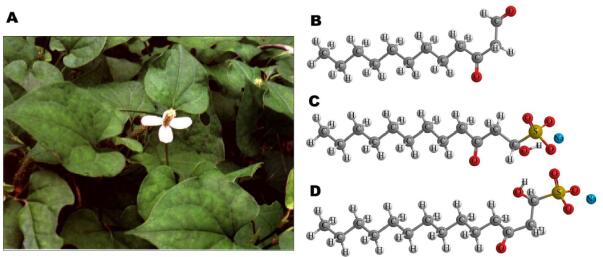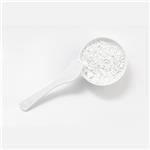What is Sodium new houttuyfonate?
Feb 11,2020
Sodium new houttuyfonate (SNH), is an addition product of active ingredient houttuynin which could inhibit a variety of bacteria.[1]


The structure of sodium new houttuyfonate origins from Houttuynia cordata Thunb. Houttuynia cordata Thunb is a common vegetable consumed in Southwest China as well as an herb used in traditional Chinese medicine for hundreds of years. In April 2003, it was approved by the State Administration of Traditional Chinese Medicine of the People's Republic of China as one of the component herbs in a Chinese herb formula to prevent severe acute respiratory syndrome (SARS). Recently, several studies also provide scientific data to support and unveil its antibacterial anti-inflammatory, and antiviral activities. Houttuynin (decanoyl acetaldehyde, C12H22O2, MW = 198.3) is the main antibacterial ingredient in volatile oil of Houttuynia cordata Thunb. As houttuynin is chemically unstable, sodium houttuyfonate (SH, sodium 1-hydroxy-3-oxododecane-1-sulfonate, C12H23NaO5S, MW = 302.4) and sodium new houttuyfonate (SNH, sodium lauroyl-α-hydroxyethyl sulfonate, C14H27NaO5S, MW = 330.4), analogue of sodium houttuyfonate, were synthesized and have been approved by China Food and Drug Administration to be used in clinical practice mainly in the formulations of tablets and injection. Due to its improved chemical and pharmacological properties, SNH has replaced houttuynin, and to a large extent SH, as an effective therapeutic agent for respiratory infections and inflammatory diseases such as acute or chronic bronchitis and pneumonia in clinical settings. Earlier studies indicated that a variety of bacteria could be inhibited by SNH with gram-positive bacteria showing a higher sensitivity to the compound than gram-negative bacteria in vitro. [2-3]
Sodium new houttuyfonate (SNH) contains a hydrophilic sulfinyl head and a hydrophobic alkyl tail with 12 carbon atoms, which is considered to be surfactant-like structure. Although antibacterial mechanism of SNH remains unknown, it was indicated that Sodium new houttuyfonate (SNH) exerted its antimicrobial effect mainly through binding of non-polar tail group to bacterial hydrophobic membrane proteins or cytoplasmic enzymes. The hydrophobic lipid bilayer of cell membrane might be another target of aliphatic chain of SNH. Since membrane-mediated processes involved in cell wall biosynthesis, cell permeability and drug efflux are important sources of resistance of MRSA to some antimicrobials, it seems reasonable to hypothesize that MRSA will be sensitized to antimicrobials by disrupting the normal barrier function of the cell membrane. SNH was reported to exhibit potent inhibitory activity against Staphylococcus aureus, Staphylococcus epidermidis, and Klebsiella pneumoniae, etc. [4]
References
1.Moellering RC Jr. MRSA: the first half century. J Antimicrob Chemother, 2012, 67: 4–11.
2.Wang H, Liu Y, Sun H, Xu Y, Xie X, et al. In vitro activity of ceftobiprole, linezolid, tigecycline, and 23 other antimicrobial agents against Staphylococcus aureus isolates in China. Diagn Microbiol Infect Dis., 2008, 62: 226–229.
3.Gould IM, David MZ, Esposito S, Garau J, Lina G, et al. New insights into meticillin-resistant Staphylococcus aureus (MRSA) pathogenesis, treatment and resistance. Int J Antimicrob Agents, 2012, 39: 96–104.
Adjuik M, Agnamey P, Babiker A, Baptista J, Borrmann S, et al. Artesunate combinations for treatment of malaria: meta-analysis. Lancet, 2004, 363: 9–17
You may like
Is Climbazole Shampoo Safe for Hair?
Jul 10, 2025
Mechanism of Action of Terconazole
Feb 28, 2025
Lastest Price from Sodium lauryl sulfoacetate manufacturers
Sodium new houttuyfonate

US $0.00/KG2025-04-21
- CAS:
- 1847-58-1
- Min. Order:
- 1KG
- Purity:
- 98%min;CP
- Supply Ability:
- 100KG
Sodium lauryl sulfoacetate

US $5.00/kg2025-04-21
- CAS:
- 1847-58-1
- Min. Order:
- 1kg
- Purity:
- 0.99
- Supply Ability:
- 10000


